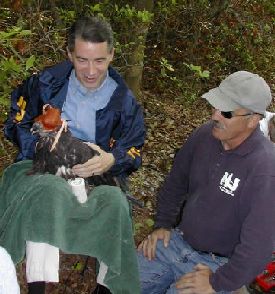| New Jersey Division of Fish and Wildlife |
| Endangered and Nongame Species Program biologists and tireless volunteers have reported another excellent season for New Jersey's bald eagles. This season we monitored a total of 34 pairs, up from last year's total of 31 pairs. Of these, 28 pairs were active (meaning they laid and incubated eggs) and produced 34 young (our preliminary count as of June 10). | |
| This season, Endangered and
Nongame Species Program biologists banded and took blood samples from 20
eaglets at 12 nests. Biologists use the eaglet blood samples to monitor
their health and measure the eagles' exposure to environmental contaminants.
Nestlings are also banded with federal and state bands to identify them
in the future, and help track survival and movements of the populations.
The population has been growing each year, starting from just one eagle nest in the 1970's and early 1980's. New Jersey gained its second nest in 1988, and the population has been growing ever since, thanks to ENSP's reintroduction efforts in the 1980's and annual management. For more details on the project, see the 2002 New Jersey Bald Eagle Management Project Report and the 2002 Summary of Eagle Nest Activity. Both files are in PDF format and require the Adobe Acrobat Reader, available free from Adobe's Web site). |
 Governor McGreevey assists ENSP Bureau Chief Larry Niles in banding operations. |